Electrical consumption of a gas boiler: how much electricity is needed to operate standard equipment
It may be news to some that gas boiler equipment requires not only gas, but also electricity. And along with gas consumption, you should also take into account the power consumption of the gas boiler, which is the heart of your heating system.
Now there will definitely be a reader who will object and be right. But he is right in that there are still gas boilers without connection to the electrical network. These are classic floor-standing units with an open combustion chamber; they require a separate room and strict adherence to strict fire safety rules in it.
Non-volatile boilers are currently used in villages remote from cities, in dachas - where there are interruptions in the electricity supply. Or if you want to save on buying equipment. We will talk about modern gas heating equipment, and it only works if there is a high-quality, reliable power supply.
The content of the article:
Why does a gas boiler need power supply?
With the advent of closed combustion chambers, gas units became dependent on electrical networks. Electricity consumption in such boilers is determined by the composition and amount of electronics in its internals.
And it is already allowed to install them not only in an isolated boiler room, but also in kitchens and bathrooms. From a security point of view, they have a high level of protection.
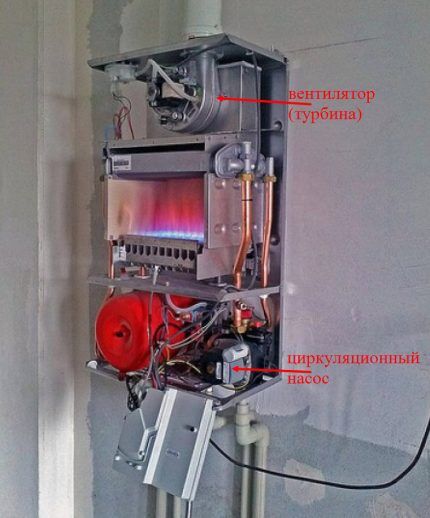
Let's list what exactly requires energy consumption:
- electric ignition;
- circulation pump;
- fan in a closed combustion chamber;
- automation (adjustment of gas supply, as well as sensors for draft, gas pressure, water, etc.).
A gas boiler with electric ignition ignites automatically from an electric spark. There is no ignition wick, which constantly burns in other ignition systems; gas is not wasted on its combustion.
At the moment an electric spark appears, some electricity is wasted, but the moment itself lasts a fraction of a second. At the same time, the electricity consumption is minimal; gas savings due to the missing igniter cover these costs. The only negative is that if there is no electricity, the boiler equipment cannot be started.
If the power supply to the network suddenly disappears, the gas cut-off device will operate. When power appears, the electric ignition will restart the heating system again without human intervention.
The circulation pump is what dramatically increases power consumption! But it is possible to minimize costs when operating a gas boiler if you use thermostats in all rooms, integrating them into the overall circuit for powering the pump and operating the boiler.
The programmer also significantly increases the economic result.The thermostat only helps to maintain a stable set temperature, and the programmer is able to set day/night operating modes, changes by day of the week, etc.

A fan (turbine) in a closed combustion chamber also consumes electricity, but less than a circular pump. The costs are justified by improved smoke removal. Boiler with coaxial chimney does not burn oxygen in the room, does not allow carbon monoxide to escape and is less noisy.
Automation in a gas boiler increases its final cost, but with it, controlling the heating system comes down to setting the desired temperature and pressing just one button.
Electricity is needed to operate the controller that regulates the gas supply and many sensors. Its consumption depends on how complex the automation is, but in general we are talking about low-cost energy consumption.
Electricity consumption of a gas boiler in numbers
Usually everyone is primarily interested in gas consumption. And the question of how much electricity a typical gas boiler consumes seems to fade into the background. Let's figure it out.
The energy-dependent gas boiler is connected to an alternating current network with standard characteristics: 220 V and 50 Hz. For stable operation of the unit, it is important that the voltage does not drop beyond 195 V. At lower voltages, electrical components will go haywire and start to shut down.
Minimum electricity consumption
The power requirement is different at different stages of operation.The minimum electrical consumption of a gas boiler is 65 W. This is in the operating phase of the circular pump, and at the moment of electric ignition - 120 W, i.e. almost twice as high. If the fan is turned on, then it also consumes electricity - another 30-35 W.
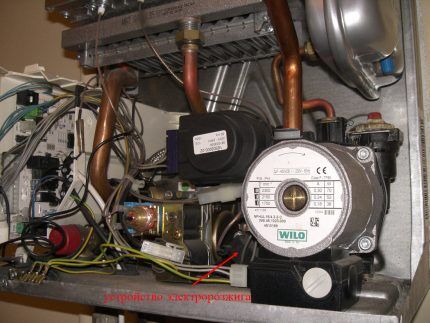
Let's draw conclusions. Electric ignition requires 120 W, then with the pump and fan running, the electricity consumption will be:
65 + 30(35) = 105(110) W
This is the minimum daily electricity consumption. This does not take into account the electricity consumption of other elements of the heating unit - the same automation. It may be insignificant, but the final result will increase.
And it should also be noted that the figures are given for a single-circuit device, i.e. Only heating without hot water supply is taken into account. If we take the same thermal power, but double-circuit boiler, power consumption will be higher.
What does the technical data sheet of a gas boiler say?
The characteristics of any gas boiler contain information about power consumption. Having studied the technical documentation for products from Bosch, Baxi, Vaillant, Ariston and others, we see that the electrical power of floor-standing units ranges from 100 to 200 W, and floor-standing units - from 15 to 160 W.
But since heating systems with floor-standing boilers often use separately installed circulation pumps. It is important not to forget about them and take into account additional power consumption.
And here is a visual comparison of power consumption with hot water supply (double-circuit boiler) and without hot water supply (single-circuit boiler): a floor-standing single-circuit boiler with a power of 30 kW consumes 15 W, a double-circuit one with a power of 30 kW consumes 150 W.
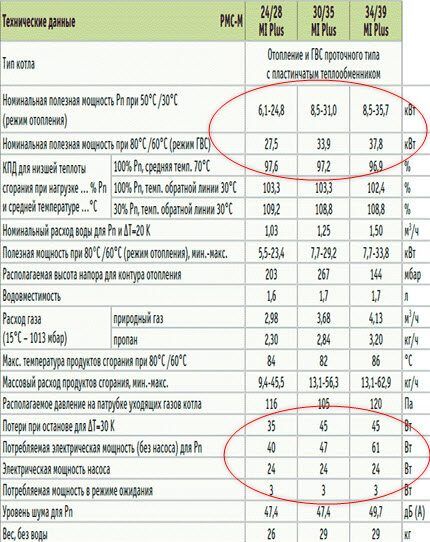
Different manufacturers ambiguously describe their power consumption in the characteristics of gas boilers.
This can be one general line or detailed:
- electricity consumption by the pump;
- electric power without pump;
- shutdown losses;
- standby consumption.
Consumption for all items is indicated in W.
Calculation of power consumption using an example
To calculate the kilowatts of electricity consumed by a gas boiler, we do a classic calculation of energy consumption - the same as for other electrical appliances. We base it on the electrical power of the boiler indicated in the technical data sheet. The manufacturer sets this parameter to a maximum value that actually exceeds the actual average value.
Example.
Let's say we have a single-circuit gas boiler Baxi Luna 31.310 Fi, its useful thermal power is 31 kW, power consumption is 165 W.
We calculate the daily consumption of electrical energy for preparation coolant. We multiply the power consumption by the number of operating hours of the boiler.
Let's say the heating doesn't turn off 24 hours a day:
165 W × 24 hours = 3960 Wh or 3.96 kWh - this is the maximum daily electricity consumption
Now we calculate how much electricity in kilowatt-hours a gas heating boiler consumes per month. We multiply the number of kilowatts consumed per day by the number of days in a month (30 days):
3.96 kWh × 30 days = 118.8 kWh is the maximum monthly electricity consumption.
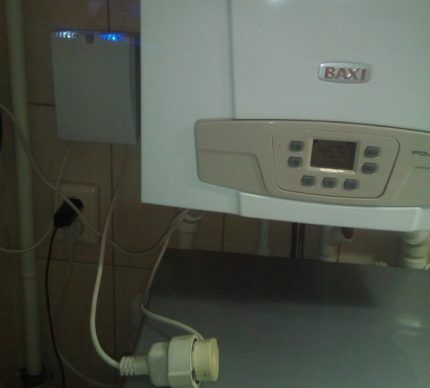
And finally, you need to get the electricity consumption for the year or heating season. Since we are talking about a single-circuit boiler and, accordingly, heating without hot water supply, let’s take the duration of the heating season to be 7 months.
Then: 118.8 kW×h×7 = 831.6 kW×h - maximum electricity consumption for the entire heating season.
For a double-circuit boiler, 12 months must be taken into account - although in economical mode, the boiler also operates in the summer months.
How to reduce energy costs?
We will proceed from the fact that, firstly, electricity consumption directly depends on the thermal power of the heating boiler. And, secondly, most of the electricity consumed is taken by the circulation pump, which circulates the coolant in the pipes so that the pipes and heating radiators warmed up slowly.
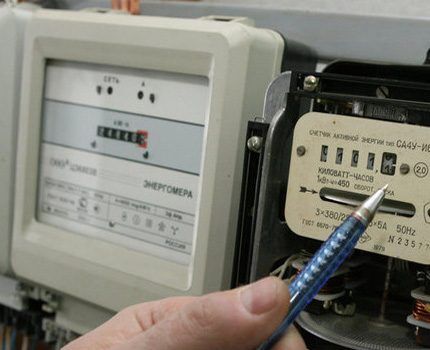
Let's name a number of specific proposals for those who would still like to reduce energy costs:
- Opt for a non-volatile unit. Most likely, this will be a floor-mounted option. In terms of functionality and comfort, alas, it is not able to compete with its energy-dependent analogue models.
- Buy a volatile device, but of low power. Here, of course, there is a significant limitation - one cannot ignore the number of heated square meters. If, for example, you need to heat 180-200 m² of a private house, then a gas boiler with a capacity of 20-24 kW is needed. And no less.
- Carefully study the product lines of different brands. Each model has its own nuances and, perhaps, for some of them you will see the most attractive power consumption figures in the technical specifications.
- Analyze what makes up the total cost of paying for electricity. Perhaps the share of these costs attributable to a gas boiler is negligible, and attention needs to be switched to other objects that really consume electricity excessively.
- How do you like using alternative energy - say, solar panels or collectors on the roof of a house?
And yet, in pursuit of saving electricity, do not bring your own actions to the point of absurdity. Do not forget that gas units consume little electricity, since their main fuel resource is not electricity, but natural or liquefied gas.
UPS for a gas boiler and its power consumption
If there is a loss of electricity in the network, the gas unit will switch to emergency operation, which threatens the breakdown of expensive components. And a UPS (uninterruptible power supply) will come to the rescue in such situations.

Type "line-interactive" - the most popular UPS, according to numerous customer reviews. They contain a voltage stabilizer, which is able to respond to voltage drops in the network within 10%; if this value is exceeded, a switch to power from the battery follows.
Off-line type - these are uninterruptible power supplies without a voltage stabilizer. They help out in case of a sudden power outage, but do not protect against mains voltage fluctuations.
On-line type - the most advanced UPS. They smoothly switch from mains power to battery power and vice versa. The only drawback is that not everyone can afford their price.
When a gas boiler is started, electricity consumption increases by at least two, or even three or four times. Even if it is a short moment, lasting a second or two, we still take UPS for gas boiler heating to the maximum and with power reserves. For a gas boiler with an electric power of 100 W, you need a UPS with a power of at least 300 W (with a reserve of up to 450-500 W).
As for the battery capacity, let’s say one battery with a capacity of 50 Ah is enough for 4-5 hours of operation with an electrical consumption of 100 W. To ensure 9-10 hours of operation, you need to have two such batteries, etc.
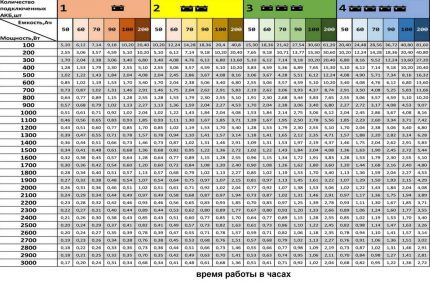
And finally, will the UPS consume electricity for its needs? It all depends on efficiency. If we take efficiency = 80%, then for our 300 W UPS the consumption together with the load will be:
300 W / 0.8 = 375 W, where 300 W is the load, the remaining 75 W is the consumption of the UPS itself.
The given calculation example is conditional and is applicable for simple uninterruptible power supplies, namely for the moment when mains voltage surges become above a certain level - more than 10%. When the network has standard 220 V, the UPS consumes almost nothing.
It is better to entrust detailed calculations for calculating the power of the UPS, the capacity of the batteries and the additional costs of electricity in connection with the installation of a UPS in the heating network to an electrician.
Conclusions and useful video on the topic
How to choose a gas boiler (the video contains information about volatile boilers and their components that require electricity to operate):
How much electricity does a gas boiler consume (the author of the video measures it with a wattmeter):
Autonomous power supply for a gas boiler (experience of a home “craftsman”):
When buying a gas boiler, put the task of reducing power consumption at one of the last places. The cost of paying for electricity is incomparably lower than the obvious plus - saving up to 30% of gas consumption.
The main thing is that in your area there are no problems with sudden power outages for a long time. Well, and, of course, boiler automation provides more opportunities for setting up and monitoring the unit during its operation.
Please leave comments in the block below, ask questions, post photos on the topic of the article. Share how much energy your gas unit consumes during operation. It is possible that your advice on savings and boiler operation rules will be useful to site visitors.




Good afternoon.Please explain how exactly the time relay in the last video works? Thank you